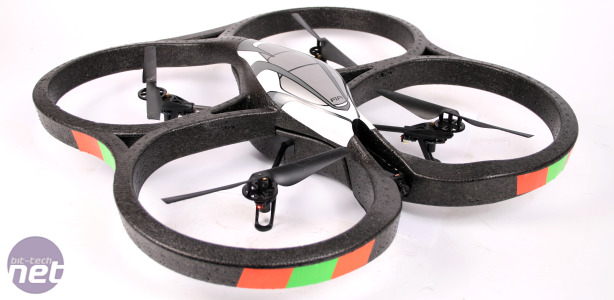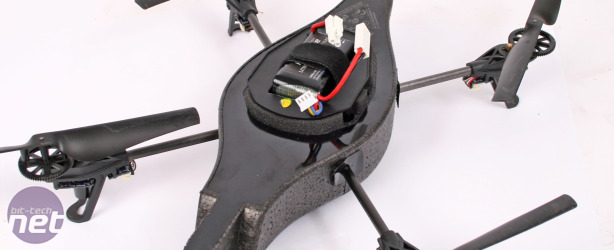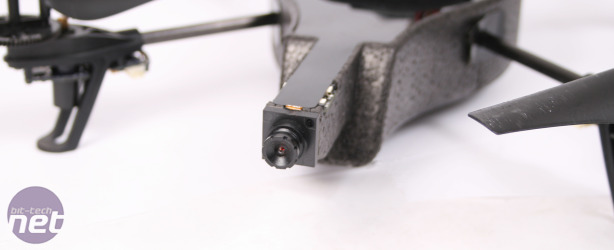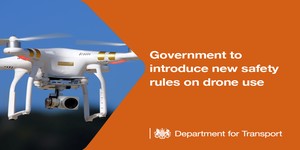
Parrot AR.Drone Review
Manufacturer: ParrotUK Price (as Reviewed): £299 (inc. VAT)
US Price (as Reviewed): $299 (ex. tax)
Due for release on 18 August in the UK and in September in the US.
We get bombarded by emails letting us know that such-and-such has launched or that company X is holding an event for some reason. A fair few of these mails are tat, fired off by marketing managers or company reps desperate to get people to attend their event. Occasionally though something catches our eye, such as the AR.Drone.
The AR.Drone is a remote-controlled quadricopter - a helicopter with four propellers - that has been designed and developed by French company Parrot. The company is a Wi-Fi and networking specialist, and made its name in the automotive industry - if you connect your phone or MP3 player to your car stereo then you’re probably using Parrot tech.
It’s the use of this expertise that makes the AR.Drone unique, as it’s not controlled via a remote control like a regular RC helicopter. The AR.Drone is actually controlled via an app for iPhone or iPod Touch, with the Apple device connecting to the AR.Drone via an ad-hoc network created by the quadricopter. Needless to say, we were intrigued.
Hardware
The AR.Drone is built around an ARM9 processor and 128MB of DDR RAM running at 200MHz. It’s not much, but it’s enough to run the small Linux OS that forms the brain of the device. The guts of the AR.Drone also contain a wireless 802.11b/g antenna, a 3-axis accelerometer, a 2-axis gyrometer and a high-precision, single-axis yaw gyrometer.In addition to this, the AR.Drone sports an ultrasound altimeter and a camera on its base which point at the floor, and a camera on its nose which points ahead. There is no denying that the tech crammed into the AR.Drone is impressive, and to avoid it all getting pulped the first time you perform a crash landing it needs some form of protection.
This comes in the form of a moulded EPP hull that holds the electronics firmly in place. On top of this fits a shell - the coloured upper part of the AR.Drone - that braces the battery in place. The upper shell comes in two flavours, an outdoor one that's smaller, lighter and only covers the heart of the machine, and an indoor version that encompasses the blades too for extra safety.
Once your iPhone or iPod Touch has connected to the ad-hoc WiFi network of the AR.Drone, the app allows you to control it via on-screen controls and the accelerometer in the iPhone or iPod. We used an iPhone. The controls for the AR.Drone are straightforward: tilting the phone forward moves the drone forward, tilting the phone left makes the drone bank left, and so on. Rotation and altitude control is handled by an on-screen joystick.
When the AR.Drone is left to its own devices, it uses the on-board ultrasound altimeter to hover in place, maintaining its height and bearing. The downward facing camera also comes into play here, allowing the AR.Drone to work out if it’s being blown out of place by a breeze and adjust accordingly.
One of the most fun features is the forward facing camera, which runs at a resolution of 640 x 480 pixels, and streams the video to the controlling device. This effectively allows you to pilot the drone even when it’s out of line of sight (perfect for sneak attacks) and the feed can be recorded too. The AR.Drone also supports augmented reality games, whereby targets or monsters are added to the image displayed on the iPhone's screen that then have to be shot down. You can also use this function to have dogfights between two drones, though we didn’t get to test how well this works.
The whole unit is powered by a 3-cell 1,000mAh battery which only lasts around 12 or 13 minutes. We’re told that this is fairly typical for a remote-control helicopter, especially one with four blades, but it's a fairly short amount of time. We can understand why the battery life is under 15 minutes, as bigger batteries weigh more and thus more energy is needed to keep them aloft, creating a circular argument. However, if you want to get a long session of play with the AR.Drone you will certainly need to purchase a few more batteries.
We should also mention that the control software for the AR.Drone is Open Source; while it only currently runs on the iPhone and iPod Touch, versions for Android and other devices should be forthcoming.

MSI MPG Velox 100R Chassis Review
October 14 2021 | 15:04











Want to comment? Please log in.